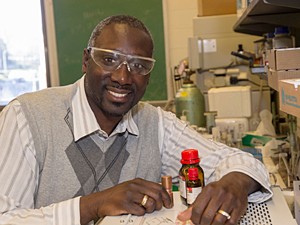
UC Research Demonstrates Why Going Green Is Good Chemistry
Shaken, not stirred, is the essence of new research thats showing promise in creating the chemical reactions necessary for industries such as pharmaceutical companies, but eliminating the resulting waste from traditional methods.
James Mack, a University of Cincinnati associate professor of chemistry, will present this research into greener chemistry on
April 9, at the annual meeting of the American Chemical Society in New Orleans.
Instead of using solutions to create chemical reactions needed to manufacture products such as detergents, plastics and pharmaceuticals, Mack is using a physical catalyst high-speed ball-milling to force chemicals to come together to create these reactions. The mechanochemistry not only eliminates waste, but also is showing more success than liquids at forcing chemical reactions.
Traditional methods dating back thousands of years involve using solutions to speed up chemical reactions that are used to make products that we use every day. However, the leftover waste or solvents can often be a volatile compound, explains Mack.
Disposal and recycling is also becoming a growing and more costly challenge for companies as they follow increasing federal regulations to protect the environment. The solvents comprise the large majority of chemicals that are handled, but the solvent doesnt do anything but serve as a mixing vehicle. For example, for every gram of pharmaceutical drug that is generated, 15 to 20 kilograms of solvent waste is generated in that process, Mack says.
Mechanochemistry can develop new reactions that we havent seen before, saving on waste and developing new science, Mack says.

James Mack
Mack also will report on how he has used a metal reactor vial to create chemical reactions, allowing recovery of the catalyst used to make the reaction, which usually cant be achieved by using solutions. He also is exploring efforts at using natural chiral agents agents that are non-superimposable, mirror images of each other to successfully mix chemicals and eliminate waste such as oil.
Macks research was supported by a $367,835 grant from the National Science Foundation that was awarded in 2011 and funded through 2014. His research received a highly competitive, $550,000 NSF CAREER Award in 2006. The CAREER Award is the NSFs most prestigious award in support of junior faculty who exemplify the role of teacher-scholars through outstanding research, excellent education and the integration of education and research within the context of the mission of their organizations.
With more than 164,000 members, the nonprofit
is the worlds largest scientific society and one of the worlds leading sources of authoritative scientific information.
Related Stories
UC Journalism to host Hall of Fame, Young Alumni Awards
Event: April 24, 2025 6:00 PM
The College of Arts and Sciences’ journalism department will host the Hall of Fame and Young Alumni Awards to celebrate the achievements and accomplishments of its graduates. Induction into the UC Journalism Hall of Fame is a special honor reserved for UC alumni who have excelled in the profession of journalism and media, or individuals who have made a significant contribution to journalism at UC.
Bradford pear trees look pretty, smell awful. Why are they...
April 2, 2025
WLWT talks to UC biology Professor Theresa Culley about Ohio's ban on the sale or planting of nonnative and invasive pear trees. The trees are showing up in many parks and wild areas where they are crowding out native species.
Bird-safe glass added to UC building
April 2, 2025
UC biologist Ronald Canterbury tells Fox19 that bird-safe glass in buildings can save untold numbers of birds.
